中文文档:https://mybatis.org/mybatis-3/zh/getting-started.html
探究已映射的 SQL 语句
现在你可能很想知道 SqlSession 和 Mapper 到底具体执行了些什么操作,但 SQL 语句映射是个相当广泛的话题,可能会占去文档的大部分篇幅。 但为了让你能够了解个大概,这里会给出几个例子。
在上面提到的例子中,一个语句既可以通过 XML 定义,也可以通过注解定义。我们先看看 XML 定义语句的方式,事实上 MyBatis 提供的所有特性都可以利用基于 XML 的映射语言来实现,这使得 MyBatis 在过去的数年间得以流行。如果你用过旧版本的 MyBatis,你应该对这个概念比较熟悉。 但相比于之前的版本,新版本改进了许多 XML 的配置,后面我们会提到这些改进。这里给出一个基于 XML 映射语句的示例,它应该可以满足上个示例中 SqlSession 的调用。
<?xml version="1.0" encoding="UTF-8" ?> <!DOCTYPE mapper PUBLIC "-//mybatis.org//DTD Mapper 3.0//EN" "http://mybatis.org/dtd/mybatis-3-mapper.dtd"> <mapper namespace="org.mybatis.example.BlogMapper"> <select id="selectBlog" resultType="Blog"> select * from Blog where id = #{id} </select> </mapper>
为了这个简单的例子,我们似乎写了不少配置,但其实并不多。在一个 XML 映射文件中,可以定义无数个映射语句,这样一来,XML 头部和文档类型声明部分就显得微不足道了。文档的其它部分很直白,容易理解。 它在命名空间 “org.mybatis.example.BlogMapper” 中定义了一个名为 “selectBlog” 的映射语句,这样你就可以用全限定名 “org.mybatis.example.BlogMapper.selectBlog” 来调用映射语句了,就像上面例子中那样:
Blog blog = (Blog) session.selectOne("org.mybatis.example.BlogMapper.selectBlog", 101);
你可能会注意到,这种方式和用全限定名调用 Java 对象的方法类似。这样,该命名就可以直接映射到在命名空间中同名的映射器类,并将已映射的 select 语句匹配到对应名称、参数和返回类型的方法。因此你就可以像上面那样,不费吹灰之力地在对应的映射器接口调用方法,就像下面这样:
BlogMapper mapper = session.getMapper(BlogMapper.class); Blog blog = mapper.selectBlog(101);
第二种方法有很多优势,首先它不依赖于字符串字面值,会更安全一点;其次,如果你的 IDE 有代码补全功能,那么代码补全可以帮你快速选择到映射好的 SQL 语句。
package com.laoxu.mybatis.executor;
import com.laoxu.mybatis.mapper.PersonMapper;
import com.laoxu.mybatis.modal.Person;
import org.apache.ibatis.io.Resources;
import org.apache.ibatis.session.SqlSession;
import org.apache.ibatis.session.SqlSessionFactory;
import org.apache.ibatis.session.SqlSessionFactoryBuilder;
import java.io.IOException;
import java.io.InputStream;
public class start {
public static void main(String[] args) throws IOException {
// user.dir指定了当前的路径
String userDir = System.getProperty("user.dir");
System.out.println(userDir);
// 获取类路径
String classPath = start.class.getResource("/").getPath();
System.out.println(classPath);
// 根据当前类路径下的相对路径 (classPath + {path})
String resource = "mapper/mybatis-config.xml";
InputStream inputStream = Resources.getResourceAsStream(resource);
SqlSessionFactory sqlSessionFactory = new SqlSessionFactoryBuilder().build(inputStream);
// 方式一
// 开启一个会话
// try (SqlSession session = sqlSessionFactory.openSession()) {
// Person person = session.selectOne("com.laoxu.mybatis.mapper.PersonMapper.getPersonById", "20210420172645864088a2a1ba11eb886d525400146075");
// System.out.println(person);
// }
// 方式二
// 开启一个会话
try (SqlSession session = sqlSessionFactory.openSession()) {
PersonMapper personMapper = session.getMapper(PersonMapper.class);
System.out.println(personMapper.getPersonById("20210420172645864088a2a1ba11eb886d525400146075"));
}
}
}
- 读取配置并存到Map中
1、组装mapper映射器
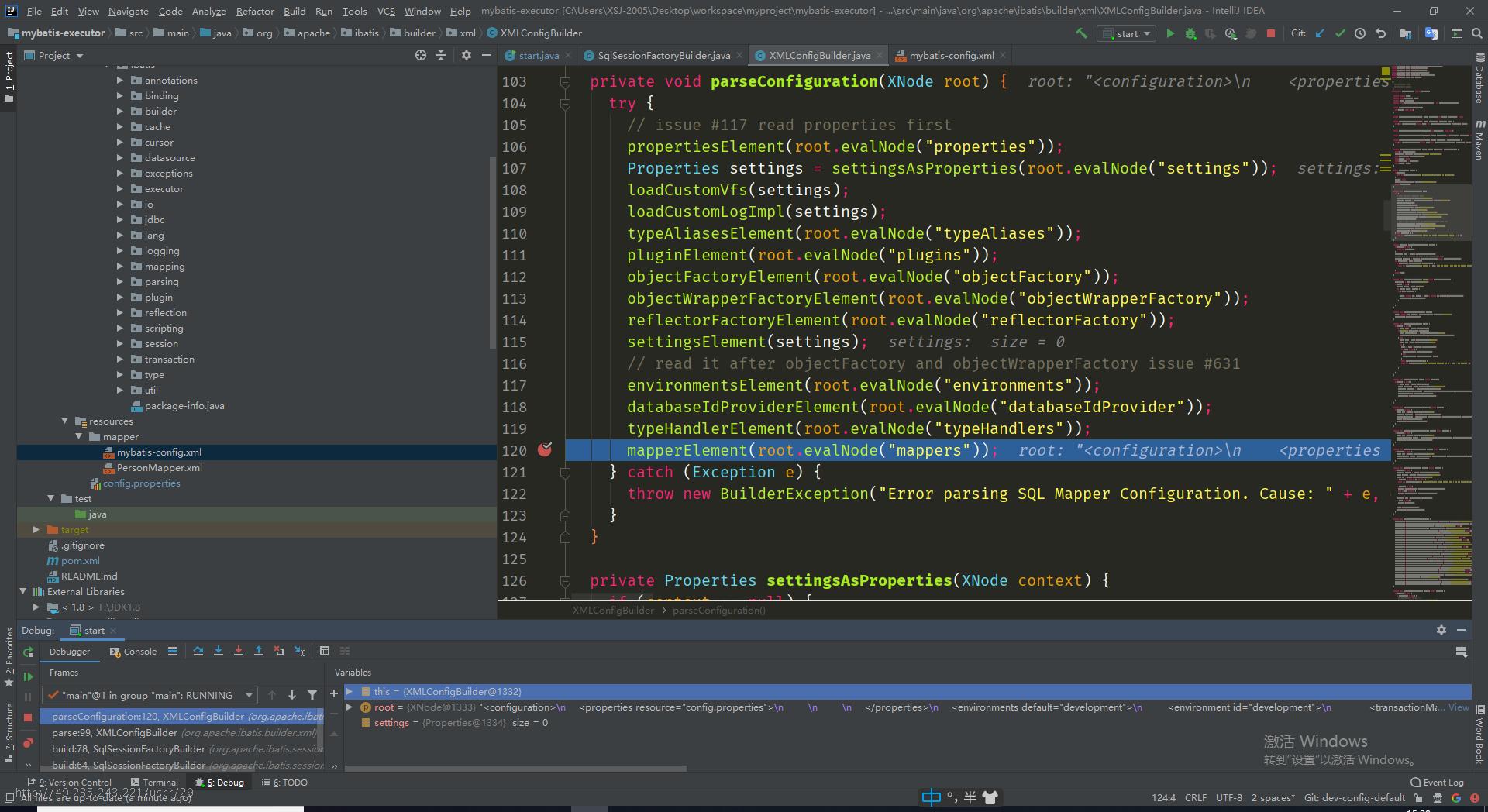
2、获取子标签名称
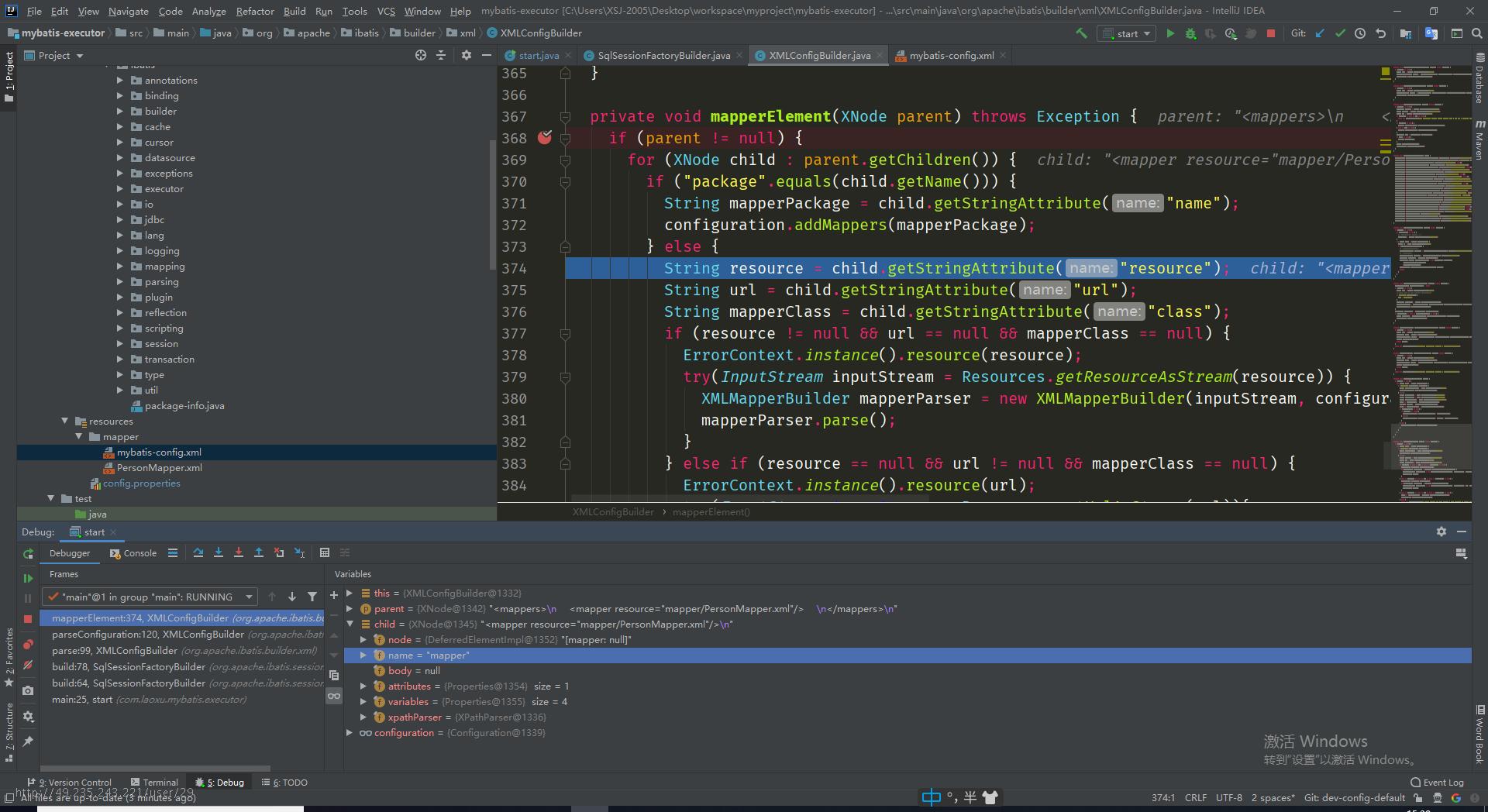
3、拿到resource属性值
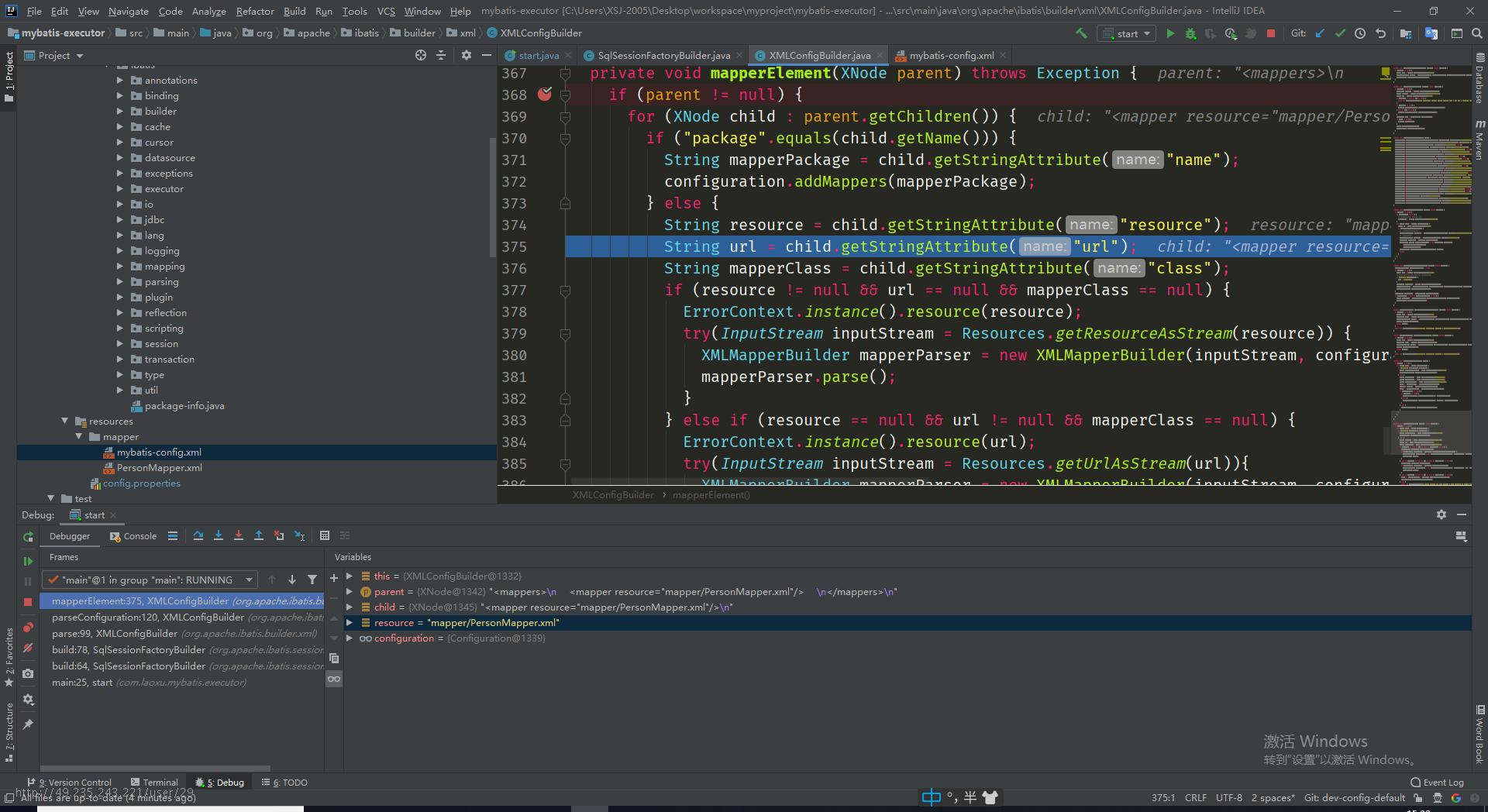
4、mapperParser解析器进行解析
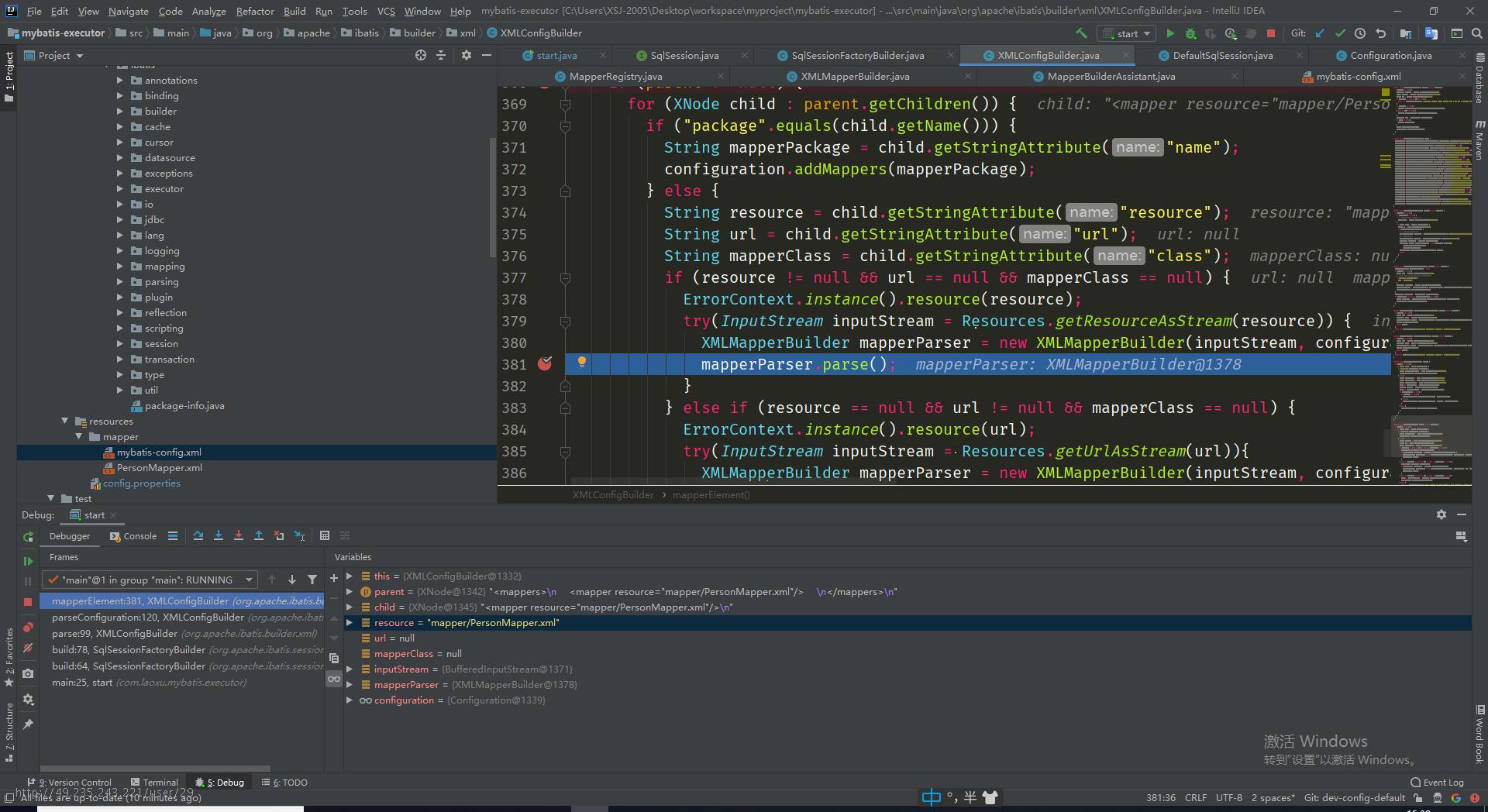
5、添加映射代理工厂Map
public void parse() {
if (!configuration.isResourceLoaded(resource)) {
configurationElement(parser.evalNode("/mapper"));
configuration.addLoadedResource(resource);
bindMapperForNamespace();
}
parsePendingResultMaps();
parsePendingCacheRefs();
parsePendingStatements();
}
private void bindMapperForNamespace() {
String namespace = builderAssistant.getCurrentNamespace();
if (namespace != null) {
Class<?> boundType = null;
try {
boundType = Resources.classForName(namespace);
} catch (ClassNotFoundException e) {
// ignore, bound type is not required
}
if (boundType != null && !configuration.hasMapper(boundType)) {
// Spring may not know the real resource name so we set a flag
// to prevent loading again this resource from the mapper interface
// look at MapperAnnotationBuilder#loadXmlResource
configuration.addLoadedResource("namespace:" + namespace);
configuration.addMapper(boundType);
}
}
}
核心映射器接口加载代码:
从第3点拿到的resource属性值mapper/PersonMapper.xml文件进行解析,得到namespace=com.laoxu.mybatis.mapper.PersonMapper
boundType = Resources.classForName(namespace);
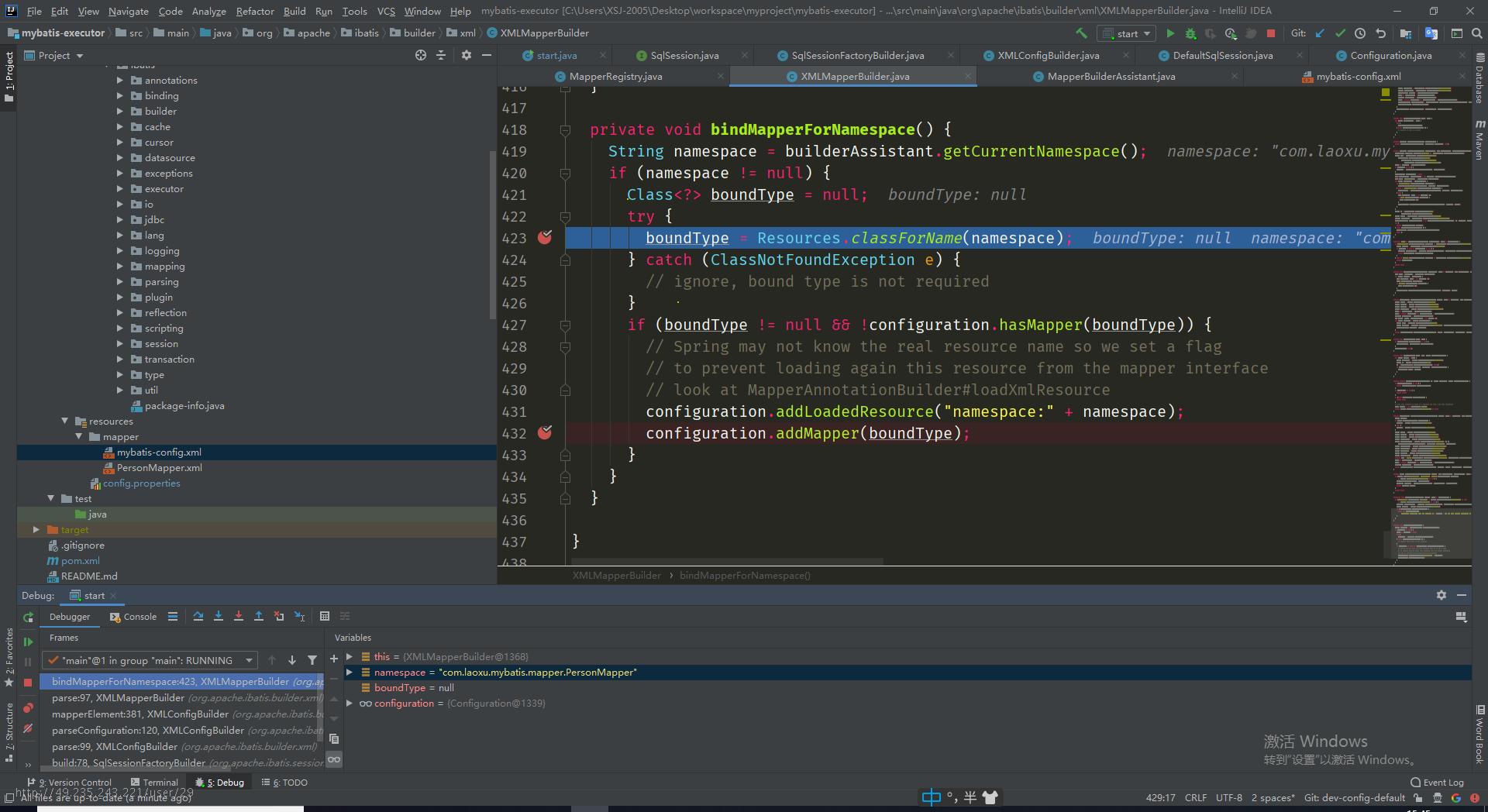
核心添加代码:
configuration.addMapper(boundType);
添加到全局映射代理工厂Map
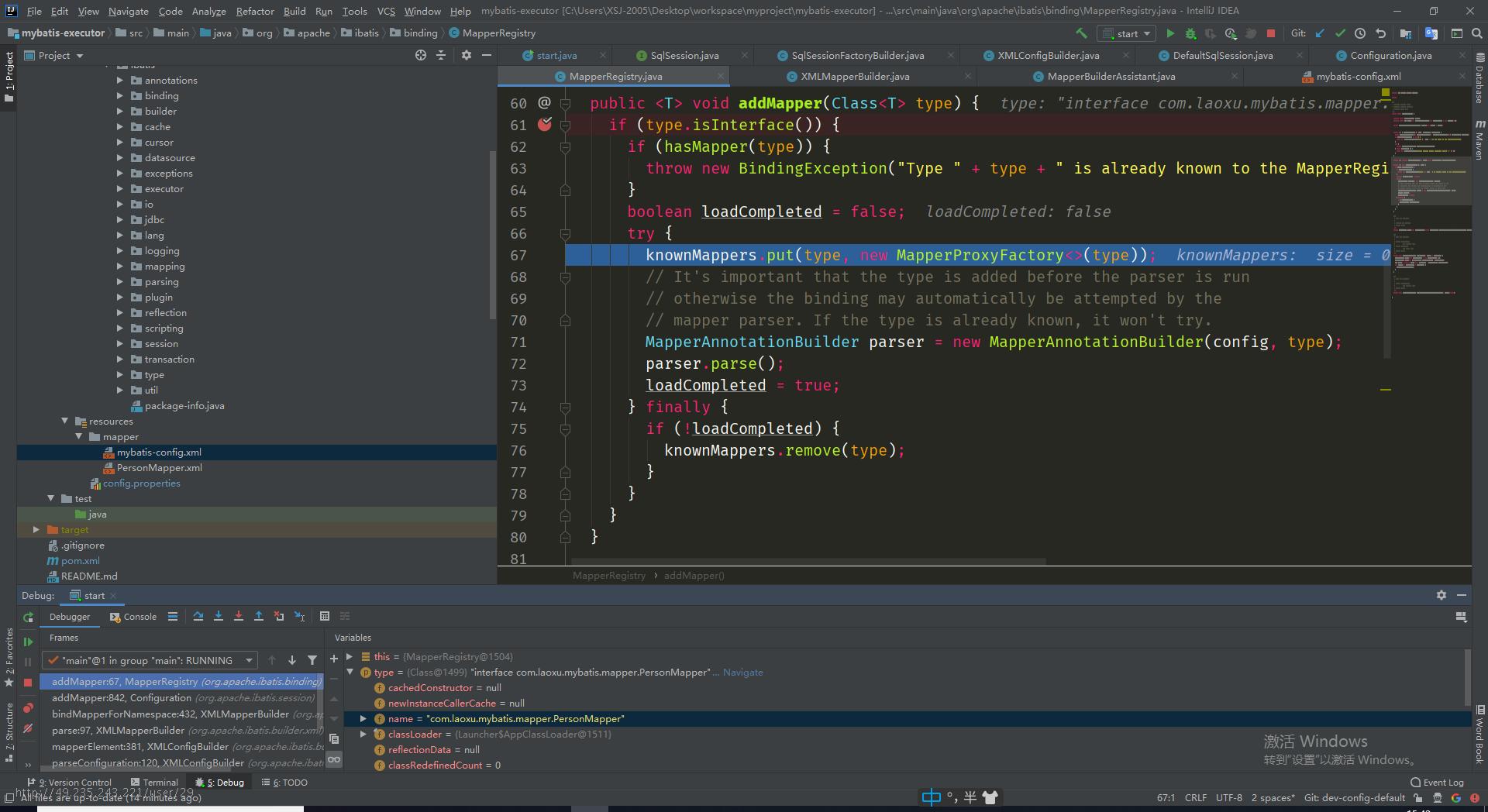
- 从全局映射代理工厂Map获取对应的映射器进行映射
PersonMapper personMapper = session.getMapper(PersonMapper.class);
1、获取映射器
@Override
public <T> T getMapper(Class<T> type) {
return configuration.getMapper(type, this);
}
public <T> T getMapper(Class<T> type, SqlSession sqlSession) {
return mapperRegistry.getMapper(type, sqlSession);
}
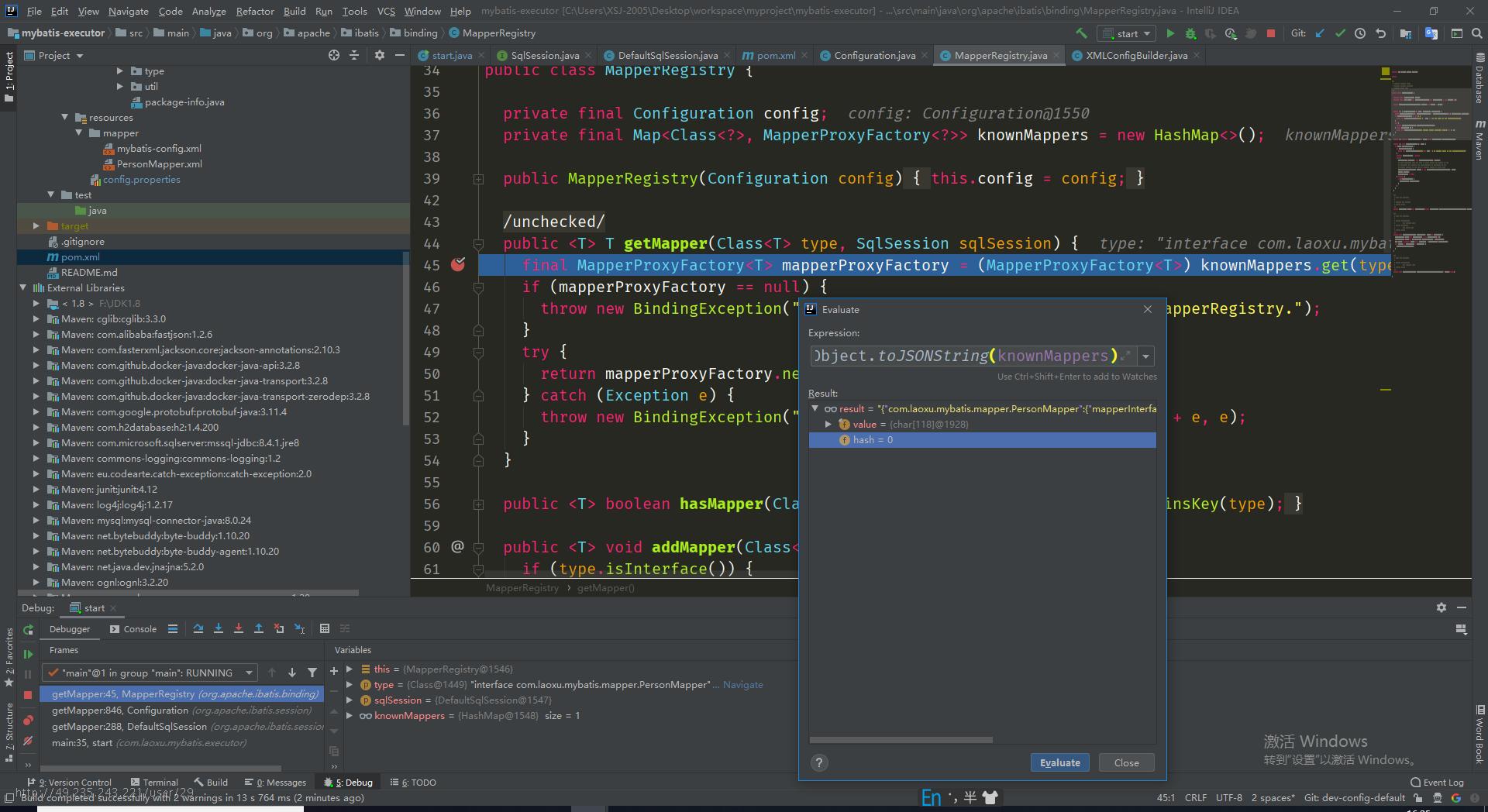
映射代理工厂map: knowMappers
实例化映射代理:
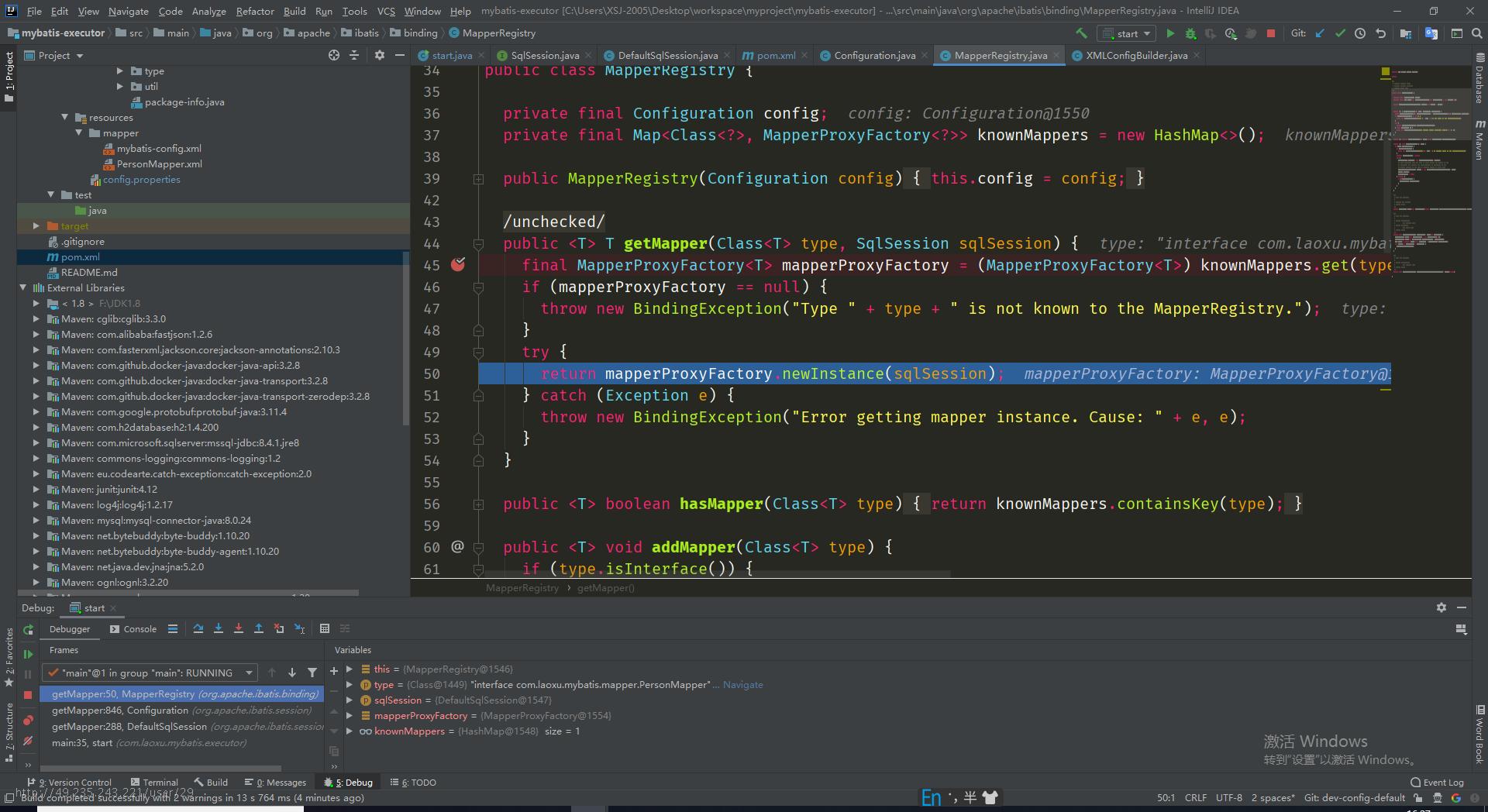
public T newInstance(SqlSession sqlSession) {
final MapperProxy<T> mapperProxy = new MapperProxy<>(sqlSession, mapperInterface, methodCache);
return newInstance(mapperProxy);
}
protected T newInstance(MapperProxy<T> mapperProxy) {
return (T) Proxy.newProxyInstance(mapperInterface.getClassLoader(), new Class[] { mapperInterface }, mapperProxy);
}
jdk动态代理:
public static Object newProxyInstance(ClassLoader loader,
Class<?>[] interfaces,
InvocationHandler h)
// 参数1:真实对象的类加载器
// 参数2:真实对象实现的所有的接口,接口是特殊的类,使用Class[]装载多个接口
// 参数3:InvocationHandler接口实现类
上面提到的mapperProxy就是InvocationHandler接口的实现类
/**
* Copyright 2009-2021 the original author or authors.
*
* Licensed under the Apache License, Version 2.0 (the "License");
* you may not use this file except in compliance with the License.
* You may obtain a copy of the License at
*
* http://www.apache.org/licenses/LICENSE-2.0
*
* Unless required by applicable law or agreed to in writing, software
* distributed under the License is distributed on an "AS IS" BASIS,
* WITHOUT WARRANTIES OR CONDITIONS OF ANY KIND, either express or implied.
* See the License for the specific language governing permissions and
* limitations under the License.
*/
package org.apache.ibatis.binding;
import java.io.Serializable;
import java.lang.invoke.MethodHandle;
import java.lang.invoke.MethodHandles;
import java.lang.invoke.MethodHandles.Lookup;
import java.lang.invoke.MethodType;
import java.lang.reflect.Constructor;
import java.lang.reflect.InvocationHandler;
import java.lang.reflect.InvocationTargetException;
import java.lang.reflect.Method;
import java.util.Map;
import org.apache.ibatis.reflection.ExceptionUtil;
import org.apache.ibatis.session.SqlSession;
import org.apache.ibatis.util.MapUtil;
/**
* @author Clinton Begin
* @author Eduardo Macarron
*/
public class MapperProxy<T> implements InvocationHandler, Serializable {
@Override
public Object invoke(Object proxy, Method method, Object[] args) throws Throwable {
try {
if (Object.class.equals(method.getDeclaringClass())) {
return method.invoke(this, args);
} else {
return cachedInvoker(method).invoke(proxy, method, args, sqlSession);
}
} catch (Throwable t) {
throw ExceptionUtil.unwrapThrowable(t);
}
}
interface MapperMethodInvoker {
Object invoke(Object proxy, Method method, Object[] args, SqlSession sqlSession) throws Throwable;
}
@Override
public Object invoke(Object proxy, Method method, Object[] args, SqlSession sqlSession) throws Throwable {
return mapperMethod.execute(sqlSession, args);
}
}
private static class DefaultMethodInvoker implements MapperMethodInvoker {
private final MethodHandle methodHandle;
public DefaultMethodInvoker(MethodHandle methodHandle) {
super();
this.methodHandle = methodHandle;
}
@Override
public Object invoke(Object proxy, Method method, Object[] args, SqlSession sqlSession) throws Throwable {
return methodHandle.bindTo(proxy).invokeWithArguments(args);
}
}
}
InvocationHandler接口只有一个方法invoke
/*
* Copyright (c) 1999, 2006, Oracle and/or its affiliates. All rights reserved.
* ORACLE PROPRIETARY/CONFIDENTIAL. Use is subject to license terms.
*/
package java.lang.reflect;
/**
* {@code InvocationHandler} is the interface implemented by
* the <i>invocation handler</i> of a proxy instance.
*
* <p>Each proxy instance has an associated invocation handler.
* When a method is invoked on a proxy instance, the method
* invocation is encoded and dispatched to the {@code invoke}
* method of its invocation handler.
*
* @author Peter Jones
* @see Proxy
* @since 1.3
*/
public interface InvocationHandler {
/**
* Processes a method invocation on a proxy instance and returns
* the result. This method will be invoked on an invocation handler
* when a method is invoked on a proxy instance that it is
* associated with.
*
* @param proxy the proxy instance that the method was invoked on
*
* @param method the {@code Method} instance corresponding to
* the interface method invoked on the proxy instance. The declaring
* class of the {@code Method} object will be the interface that
* the method was declared in, which may be a superinterface of the
* proxy interface that the proxy class inherits the method through.
*
* @param args an array of objects containing the values of the
* arguments passed in the method invocation on the proxy instance,
* or {@code null} if interface method takes no arguments.
* Arguments of primitive types are wrapped in instances of the
* appropriate primitive wrapper class, such as
* {@code java.lang.Integer} or {@code java.lang.Boolean}.
*
* @return the value to return from the method invocation on the
* proxy instance. If the declared return type of the interface
* method is a primitive type, then the value returned by
* this method must be an instance of the corresponding primitive
* wrapper class; otherwise, it must be a type assignable to the
* declared return type. If the value returned by this method is
* {@code null} and the interface method's return type is
* primitive, then a {@code NullPointerException} will be
* thrown by the method invocation on the proxy instance. If the
* value returned by this method is otherwise not compatible with
* the interface method's declared return type as described above,
* a {@code ClassCastException} will be thrown by the method
* invocation on the proxy instance.
*
* @throws Throwable the exception to throw from the method
* invocation on the proxy instance. The exception's type must be
* assignable either to any of the exception types declared in the
* {@code throws} clause of the interface method or to the
* unchecked exception types {@code java.lang.RuntimeException}
* or {@code java.lang.Error}. If a checked exception is
* thrown by this method that is not assignable to any of the
* exception types declared in the {@code throws} clause of
* the interface method, then an
* {@link UndeclaredThrowableException} containing the
* exception that was thrown by this method will be thrown by the
* method invocation on the proxy instance.
*
* @see UndeclaredThrowableException
*/
public Object invoke(Object proxy, Method method, Object[] args)
throws Throwable;
}
回到调用代码:
PersonMapper personMapper = session.getMapper(PersonMapper.class);
实际上是进行了代理
PersonMapper personMapper = (PersonMapper)Proxy.newProxyInstance(classLoader, interfaces, mapperProxy);
当调用方法时,就会执行实现类中的方法invoke方法
@Override
public Object invoke(Object proxy, Method method, Object[] args) throws Throwable {
try {
if (Object.class.equals(method.getDeclaringClass())) {
return method.invoke(this, args);
} else {
return cachedInvoker(method).invoke(proxy, method, args, sqlSession);
}
} catch (Throwable t) {
throw ExceptionUtil.unwrapThrowable(t);
}
}
也就是调用personMapper中的getPersonById时,会调用invoke方法
try (SqlSession session = sqlSessionFactory.openSession()) {
PersonMapper personMapper = session.getMapper(PersonMapper.class);
System.out.println(personMapper.getPersonById("20210420172645864088a2a1ba11eb886d525400146075"));
}
详细例子参照:https://blog.csdn.net/yaomingyang/article/details/81040390
 mybatis源码-执行sql
mybatis源码-执行sql 恭喜注册成功,快来登录吧!
恭喜注册成功,快来登录吧!